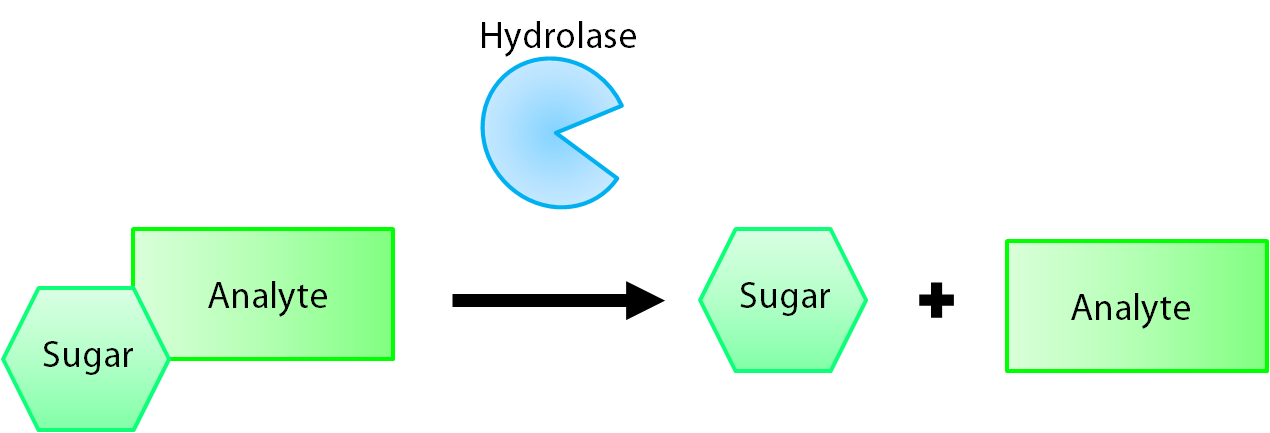Team:Calgary/Project/FRED/Reporting
From 2012.igem.org
| Line 13: | Line 13: | ||
<p>The enzymes encoded by our reporter genes are specific sugar hydrolases. This means that they target one kind of sugar and remove it from whatever compound they are attached to. We have chosen to use the sugars glucose, glucuronide, and galactose for our system. The genes reposnsible for their respective hydrolases are <i>bglX</i>, <i>uidA</i>, and <i>lacZ</i>. By having our electrochemical analyte conjugated to this sugar, when the hydrolase is expressed the sugar is cleaved from the analyte, allowing for it's electrochemical detection. A diagrammatic representation of this system is shown below in figure 1.</p> | <p>The enzymes encoded by our reporter genes are specific sugar hydrolases. This means that they target one kind of sugar and remove it from whatever compound they are attached to. We have chosen to use the sugars glucose, glucuronide, and galactose for our system. The genes reposnsible for their respective hydrolases are <i>bglX</i>, <i>uidA</i>, and <i>lacZ</i>. By having our electrochemical analyte conjugated to this sugar, when the hydrolase is expressed the sugar is cleaved from the analyte, allowing for it's electrochemical detection. A diagrammatic representation of this system is shown below in figure 1.</p> | ||
| + | |||
| + | </html> | ||
| + | [[File:Calgary2012 EchemWikiFig1.jpg|thumb|500px|center|Figure 1: Representation of cleavage of the sugar-analyte substrate by a hydrolase enzyme.]] | ||
| + | <html> | ||
<p>After the analyte is released we need to detect it. Electrochemistry is an excellent approach for this because of it's fast and quantitative nature. A voltage is applied between two electrodes and the resulting current is measured. As voltages are relative there is a third electrode called a reference electrode, allowing us to apply our voltage relative to this. By changing the applied voltage to that of the oxidation voltage of one of our analytes, the increase in current due to it's oxidation when compared to an analyte free baseline is proportional to the amount of analyte present in the solution. This process happens so quickly that you can have an output value in a matter of seconds. | <p>After the analyte is released we need to detect it. Electrochemistry is an excellent approach for this because of it's fast and quantitative nature. A voltage is applied between two electrodes and the resulting current is measured. As voltages are relative there is a third electrode called a reference electrode, allowing us to apply our voltage relative to this. By changing the applied voltage to that of the oxidation voltage of one of our analytes, the increase in current due to it's oxidation when compared to an analyte free baseline is proportional to the amount of analyte present in the solution. This process happens so quickly that you can have an output value in a matter of seconds. | ||
Revision as of 06:09, 23 September 2012


Hello! iGEM Calgary's wiki functions best with Javascript enabled, especially for mobile devices. We recommend that you enable Javascript on your device for the best wiki-viewing experience. Thanks!
A Novel Electrochemical Reporting System
For FRED to be able to tell us about the toxins he's sensing we needed a good reporter system that could function in a wide array of environments. Unfortunately the traditional fluorescent or luminescent reporters have significant drawbacks that prevent them from being useful in a tailings environment that is murky and potentially anaerobic. Due to these limitations we decided to improve upon last year's electrochemical sensor using the lacZ gene to cleave a substrate into an easily detectable analyte. Our team has developed a system that utilizes three separate reporter genes to provide a triple-output biosensor. This system overcomes traditional reporters in that it is fast, accurate, and can function in turbid environments and even in the absence of oxygen!
How does it work?
The enzymes encoded by our reporter genes are specific sugar hydrolases. This means that they target one kind of sugar and remove it from whatever compound they are attached to. We have chosen to use the sugars glucose, glucuronide, and galactose for our system. The genes reposnsible for their respective hydrolases are bglX, uidA, and lacZ. By having our electrochemical analyte conjugated to this sugar, when the hydrolase is expressed the sugar is cleaved from the analyte, allowing for it's electrochemical detection. A diagrammatic representation of this system is shown below in figure 1.
After the analyte is released we need to detect it. Electrochemistry is an excellent approach for this because of it's fast and quantitative nature. A voltage is applied between two electrodes and the resulting current is measured. As voltages are relative there is a third electrode called a reference electrode, allowing us to apply our voltage relative to this. By changing the applied voltage to that of the oxidation voltage of one of our analytes, the increase in current due to it's oxidation when compared to an analyte free baseline is proportional to the amount of analyte present in the solution. This process happens so quickly that you can have an output value in a matter of seconds.
 "
"
